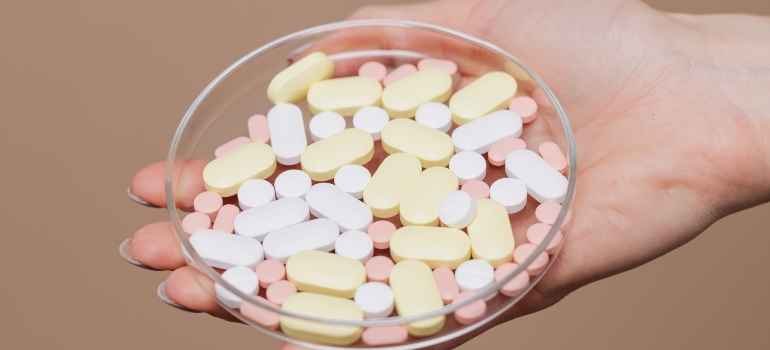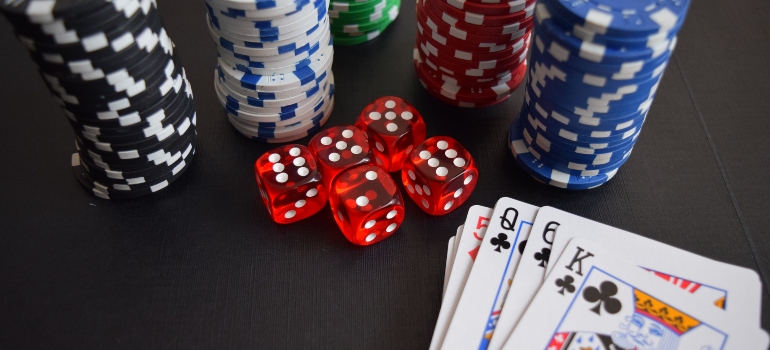Differences Between Physical and Psychological Addiction
Physical and psychological addiction are two distinct types of addiction that differ in their underlying causes and symptoms. Physical addiction, also known as physiological addiction, is a type of addiction in which the body becomes dependent on a substance. Psychological addiction, also known as behavioral addiction, is a type of addiction in which a person becomes dependent on a behavior or activity. Luckily, visiting a rehab center in Pennsylvania can help with both addictions. The primary difference between physical and psychological addiction is that physical addiction involves changes in the body that result in withdrawal symptoms when the substance is removed. In contrast, psychological addiction does not result in physical withdrawal symptoms but can cause emotional and mental distress when the behavior or activity is stopped. However, the differences between physical and psychological addiction do not stop there. Understanding both of them is key.
Jump to Section
Physical addiction
Physical addiction is a type of addiction that occurs when your body becomes dependent on a substance. This dependency can cause you to experience withdrawal symptoms if you stop using the substance. In other words, when you become physically addicted to a substance, your body begins to rely on it to function normally. This can lead to tolerance, which means that you need more of the substance to achieve the same effect. Withdrawal symptoms can be severe and can include nausea, vomiting, sweating, and shaking. In some cases, withdrawal can be life-threatening, particularly if you’re withdrawing from alcohol or benzodiazepines.

Treating physical addiction often involves a combination of medication and therapy. Medications can be used to manage withdrawal symptoms and cravings. Therapy, on the other hand, can help you address the underlying reasons for your addiction and develop healthy coping mechanisms. It’s important to seek professional help from one of the drug and alcohol treatment centers in Pennsylvania if you’re struggling with physical addiction. A healthcare professional can help you develop a personalized treatment plan that takes into account your individual needs and circumstances.
Symptoms and signs of physical addiction
If you’re concerned that you or someone you know may be struggling with physical addiction, it’s important to be aware of the symptoms and signs. One of the primary symptoms of physical addiction is withdrawal. Withdrawal occurs when you stop using the substance. At that time, your body begins to experience a range of physical and emotional symptoms. These symptoms can vary depending on the substance and the severity of your addiction. However, they usually include nausea, vomiting, sweating, shaking, anxiety, and depression. The symptoms, and their treatment, also differ by substance. If you are addicted to alcohol, for example, you will want to visit one of the alcohol rehab centers in Pennsylvania. They can provide you with specialized care.
Other signs of physical addiction include:
- Tolerance: You may need more of the substance to achieve the desired effect.
- Increased usage: You may use the substance more frequently or in larger amounts than intended.
- Difficulty quitting: You may have attempted to quit using the substance but have been unsuccessful.
- Social or occupational problems: Your substance use may have caused problems in your personal or professional life.
- Physical symptoms: You may experience physical symptoms such as weight loss, changes in appetite, and fatigue.
Physical addiction may also be accompanied by various behavioral changes, such as secretive behavior. Unfortunately, these changes may be a bit more difficult to spot.
How physical addiction affects the brain and body
Physical addiction can have a significant impact on both the brain and the body. When you become physically addicted to a substance, your brain chemistry changes. Furthermore, you may experience a range of physical and emotional symptoms. One of the primary ways physical addiction affects the brain is through dopamine release. Dopamine is a neurotransmitter that’s responsible for feelings of pleasure and reward. When you use a substance that’s addictive, your brain releases a flood of dopamine. This reinforces the behavior and encourages you to continue using the substance. Over time, your brain can become dependent on the substance to release dopamine. This can lead to physical changes in the brain. These changes can make it difficult to stop using the substance, even if you want to.

Long-term physical addiction can also lead to a range of health problems, including liver and kidney damage, heart disease, and respiratory problems. This is why it is extremely important to visit a drug rehab center in Edison NJ if you are suffering from physical addiction. Other lifestyle factors, such as poor nutrition and lack of exercise can also exacerbate these health problems.
Common physical addictions
Physical addiction can occur with a variety of substances. Here are a few examples:
- Opioids: Opioids are a type of prescription pain medication that can be highly addictive. When you become physically addicted to opioids, you may experience withdrawal symptoms if you stop using them.
- Alcohol: Alcohol is a legal substance that’s widely available and socially acceptable. However, when you become physically addicted to alcohol, you may experience withdrawal symptoms when you stop drinking.
- Nicotine: Nicotine is a highly addictive substance that’s found in tobacco products. When you become physically addicted to nicotine, you may experience cravings and withdrawal symptoms if you try to quit smoking.
- Stimulants: Stimulants, such as cocaine and methamphetamine, can be highly addictive and can lead to physical dependence over time. Withdrawal from these substances can be severe and may require medical intervention.
- Prescription medications: Prescription medications, such as benzodiazepines and stimulants, can also be highly addictive and can lead to physical dependence over time.
Treatment options for physical addiction
If you’re struggling with physical addiction, it’s important to seek professional help to develop a personalized treatment plan. That being said, there are five common treatment options that you may want to consider, including:
- Detoxification: Detoxification is the process of removing a substance from your body. This process can be uncomfortable and even dangerous in some cases, which is why it’s important to undergo detoxification under medical supervision.
- Medication-assisted treatment: Medication-assisted treatment involves the use of medications to manage withdrawal symptoms and cravings. This type of treatment is often used for opioid addiction and can be highly effective.
- Behavioral therapy: Behavioral therapy can help you address the underlying reasons for your addiction and develop healthy coping mechanisms. This type of therapy can be individual or group-based and can include cognitive-behavioral therapy, motivational interviewing, and contingency management.
- Support groups: Support groups, such as Alcoholics Anonymous or Narcotics Anonymous, can provide a supportive and non-judgmental environment for people struggling with addiction.
- Holistic therapies: Holistic therapies, such as yoga, meditation, and acupuncture, can help you manage stress and anxiety and develop a sense of overall well-being.

You can find all these options within your local rehab center in Princeton NJ. Of course, your treatment center will provide you with a personalized plan, allowing you to overcome your addiction in the most effective way.
Psychological addiction
Psychological addiction is a type of addiction that occurs when you become emotionally dependent on a behavior or activity. Unlike physical addiction, psychological addiction doesn’t cause physical withdrawal symptoms but can still have a significant impact on your life. Psychological addiction can occur with a variety of behaviors or activities, such as gambling, shopping, or using social media. When you’re psychologically addicted to a behavior, you may feel an intense urge to engage in that behavior, even if it’s causing you harm.
Psychological addiction is often characterized by a loss of control over the behavior, as well as continued engagement in the behavior despite negative consequences. This can include financial problems, relationship difficulties, and a decrease in overall well-being. All in all, psychological addiction has the potential to really stretch your Anthem rehab coverage. Therefore, it is best if you spot the symptoms and signs of psychological addiction on time.
Symptoms and signs of psychological addiction
Psychological addiction can occur with a variety of behaviors or activities and can have a significant impact on your life. One of the primary symptoms of psychological addiction is a strong and persistent urge to engage in the behavior or activity. Another common sign of psychological addiction is a loss of control over the behavior. You may find that you’re unable to stop engaging in the behavior, even if it’s causing you harm.

How psychological addiction affects the brain and behavior
Psychological addiction can have a significant impact on both the brain and behavior. When a psychological addiction to a behavior or activity you may experience a range of emotional symptoms. One of the primary ways that psychological addiction affects the brain is exactly the same as physical addiction: The release of dopamine. When you engage in behavior that’s psychologically addictive, your brain releases a flood of dopamine. This reinforces the behavior and encourages you to continue engaging in it. Over time, your brain can become dependent on the behavior to release dopamine, which can lead to changes in the brain. These changes can make it difficult to stop engaging in the behavior, even if you want to.
Psychological addiction can also have significant effects on behavior. You may find that you’re spending more time engaging in the behavior and that it’s starting to interfere with your daily life. If you do, you may want to pay a visit to a Scranton rehab center where you can get all the help that you need.
Common psychological addictions
Psychological addiction can occur with a variety of behaviors or activities. It is very important to be aware of some of the most common psychological addictions. Here are a few examples:
- Gambling: Gambling can be highly addictive, and many people become psychologically dependent on the rush of winning or losing.
- Social media: Social media can be addictive, and many people become psychologically dependent on the constant validation and feedback provided by social media platforms.
- Shopping: Shopping can be a form of escapism for some people, and can lead to psychological addiction over time.
- Internet use: Internet use, including browsing, gaming, and streaming, can be highly addictive and can lead to compulsive behavior.
- Work: Work addiction, or workaholism, can be a form of psychological addiction in which you become emotionally dependent on work as a means of validation and self-worth.

Treatment options for psychological addiction
If you’re struggling with psychological addiction, there are a variety of treatment options available to help you overcome your addiction and achieve long-term recovery. Here are five of the most common treatment options for psychological addiction:
- Cognitive-behavioral therapy (CBT): CBT is a type of therapy that helps you identify and change negative thought patterns and behaviors that contribute to addiction.
- Motivational interviewing (MI): MI is a type of therapy that helps you identify and strengthen your motivation to change addictive behavior.
- Mindfulness-based therapies: Mindfulness-based therapies, such as meditation and yoga, can help you manage stress and anxiety and develop a sense of overall well-being.
- Support groups: Support groups, such as Gamblers Anonymous or Overeaters Anonymous, can provide a supportive and non-judgmental environment for people struggling with addiction.
- Medication: In some cases, medication may be prescribed to help manage symptoms of psychological addiction.
If your addiction is mild, you may also explore additional options. For example, you may want to visit one of the sober living houses in PA, where you can recover from addiction in your own time.
Differences between physical and psychological addiction
Understanding the differences between physical and psychological addiction is important for identifying and treating addiction effectively. Here are the five key differences between the two types of addiction:
- Physical addiction is characterized by physical dependence on a substance, while psychological addiction is characterized by emotional dependence on a behavior or activity.
- Physical addiction often results in physical withdrawal symptoms when the substance is removed, while psychological addiction does not.
- Physical addiction is often treated with medication to manage withdrawal symptoms, while psychological addiction is often treated with therapy and other non-medication-based approaches.
- Physical addiction is often associated with substances such as drugs or alcohol, while psychological addiction can occur with a variety of behaviors or activities, such as gambling or social media use.
- Physical addiction can be objectively measured through tests such as drug screenings, while psychological addiction is often assessed subjectively through self-report and observation.

While these differences might seem simple and logical, there is one more thing that muddles the proverbial waters: Co-occurring physical and psychological addictions.
Co-occurring physical and psychological addictions
Co-occurring physical and psychological addictions can be a complex issue to address. When someone is struggling with both types of addiction, they may require a more comprehensive treatment plan. The plan needs to address both the physical and emotional aspects of addiction. Furthermore, co-occurring physical and psychological addictions are not uncommon. For example, someone struggling with drug addiction may also have a psychological addiction to the ritual of using drugs, such as the act of preparing and injecting the substance. Similarly, someone struggling with a gambling addiction may also have a physical addiction to the rush of dopamine that occurs during a gambling session.
Treating co-occurring physical and psychological addictions requires a multi-faceted approach that addresses both types of addiction. In some cases, intervention for addiction may be necessary. This may include a combination of medication-assisted treatment to manage physical withdrawal symptoms, as well as therapy to address the emotional aspects of addiction.
Treatment options for co-occurring addictions
When someone is struggling with co-occurring physical and psychological addictions, treatment can be challenging but is still possible. Here are some treatment options for co-occurring addictions:
- Medication-assisted treatment: Medications can be prescribed to manage physical withdrawal symptoms and cravings associated with physical addiction.
- Behavioral therapies: Behavioral therapies such as cognitive-behavioral therapy (CBT) and motivational interviewing (MI) can help you address the emotional and psychological aspects of addiction.
- Support groups: Support groups, such as Narcotics Anonymous or Gamblers Anonymous, can provide a supportive and non-judgmental environment for people struggling with addiction.
- Integrated treatment programs: Integrated treatment programs are specifically designed to address co-occurring addictions and can provide a comprehensive approach to treatment.

Regardless of which treatment option you choose, you can augment it with a variety of therapy modalities. There are many reasons to consider yoga during addiction treatment, for example. That being said, even if you choose the best treatment program, undergoing addiction treatment is not easy. You, or your loved one, will need ample support throughout the entire process.
Supporting a loved one with addiction
Watching a loved one struggle with addiction can be difficult and overwhelming. However, you can make a difference if you:
- Educate yourself: Learn about addiction and its effects on the body and mind. This will help you understand what your loved one is going through and how best to support them.
- Be non-judgmental: Avoid blaming or shaming your loved one for their addiction. Instead, offer support and encouragement.
- Offer help: Offer to help your loved one find treatment options or attend appointments with them. However, it’s important to respect their autonomy and not force them into treatment.
- Practice self-care: It’s important to take care of yourself as well. Make sure you have a support system and take time for yourself to avoid burnout.
- Encourage healthy habits: Encourage your loved one to engage in healthy habits, such as exercise, healthy eating, and getting enough sleep.
- Set boundaries: It’s important to set boundaries to protect your own well-being. This may include setting limits on your availability or not enabling your loved one’s addiction.
How to recognize addiction in a loved one?
Recognizing addiction in a loved one can be challenging, but there are signs to look out for. Some of the most common signs include:
- Changes in behavior: Your loved one may become more secretive, withdraw from social activities, or act differently than usual.
- Physical changes: Your loved one may experience weight loss or gain, have bloodshot eyes, or appear tired and disheveled.
- Changes in mood: Your loved one may be irritable, anxious, or depressed.
- Increased tolerance: Your loved one may require more of a substance to achieve the desired effect.
- Withdrawal symptoms: Your loved one may experience physical symptoms such as tremors, sweating, or nausea when not using a substance.
- Loss of interest: Your loved one may lose interest in hobbies, activities, or responsibilities that were once important to them.

There may be additional signs, depending on a variety of factors, such as age. Knowing how to spot the signs of young adult addiction can be quite different than knowing how to spot the signs of addiction in adults. Either way, if you suspect that a loved one may be struggling with addiction, it’s important to approach them with empathy and understanding. Avoid judgment or criticism and offer your support. Encourage them to seek professional help and offer to help them find treatment options.
Ways to offer support and encouragement
Offering support and encouragement to someone struggling with addiction can make a significant difference in their recovery journey. However, you want to make sure that you:
- Listen without judgment: Offer a listening ear without judgment or criticism. Let your loved one know that you’re there for them and that you care about their well-being.
- Encourage treatment: Encourage your loved one to seek professional help and offer to help them find treatment options.
- Attend appointments with them: Offer to attend appointments with your loved one to provide support and encouragement.
- Offer practical help: Offer to help with practical tasks, such as grocery shopping or transportation to appointments.
- Encourage healthy habits: Encourage your loved one to engage in healthy habits, such as exercise, healthy eating, and getting enough sleep.
- Celebrate successes: Celebrate your loved one’s successes, no matter how small. Recovery is a journey, and every step forward should be acknowledged and celebrated.
Remember, offering support and encouragement is essential, but it’s also important to take care of yourself. You will want to create your own support system, as well as prioritize your own well-being.
Resources for family members and friends of those with addiction
Having a loved one with addiction can be a challenging and emotional experience. Fortunately, there are plenty of resources available to help family members and friends provide support and take care of their own well-being. Here are some resources to consider:
- Support groups such as Alcoholics Anonymous and Narcotics Anonymous provide a safe and supportive space for family members and friends of those with addiction to connect and share their experiences.
- Therapy can provide a safe and confidential space to process emotions and develop coping strategies for dealing with the challenges of having a loved one with addiction.
- Educational resources, such as books and online courses, can provide valuable information and guidance on addiction and how to support a loved one.
- Community organizations, such as addiction treatment centers and mental health clinics, may offer resources and support for family members and friends.
- Hotlines, such as the National Helpline for Substance Abuse and Mental Health Services Administration (SAMHSA), offer confidential support and guidance for those dealing with addiction and their loved ones.
Understanding the differences between physical and psychological addiction is crucial in recognizing and addressing addiction-related issues. Both types of addiction can have a significant impact on the brain and body and can co-occur with each other. Furthermore, treatment options for physical and psychological addiction may differ. Physical addiction often requires medical detoxification and psychological addiction often requires therapy or behavioral interventions. Recognizing the differences between physical and psychological addiction can help you seek appropriate treatment.